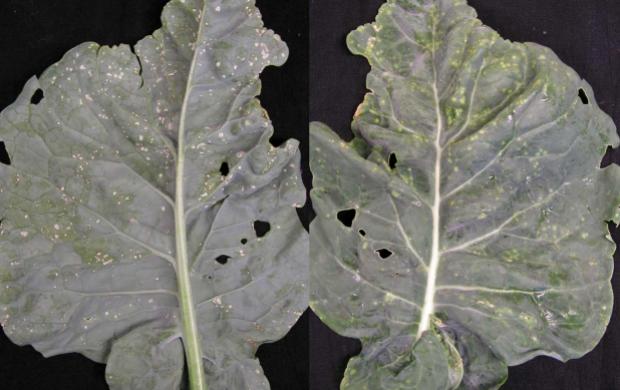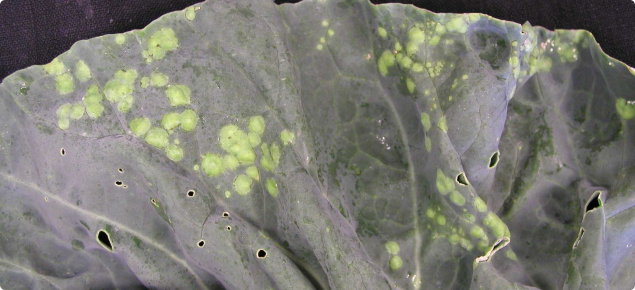Infection and symptoms
White blister can infect a plant both locally and/or systemically. Symptoms vary depending on infection type. The disease mainly infects plant parts that contain chlorophyll, that is the green parts, however systemic infections can affect any part.
Symptoms of localised infections are white ‘blisters’, which in the early stages are seen on the underside of leaves. As symptoms progress, circular areas of light green to yellow discolouration appear on the upper leaf surface, corresponding to white blisters on the underside of the leaves. The blisters contain white powdery spores which are spread by wind when released. Spores can be released at any time of day.
With systemic infections, the disease grows throughout the plant’s tissue, which is more difficult to control. Abnormal growth, distortion of affected plants or the formation of galls indicate systemic infection.
The galls and distorted plant parts contain another type of spore which can be spread in crop debris and on seed. In seedlings, affected plants may look ‘leggy’ and taller than non-affected seedlings due to the abnormal growth.
Currently 17 different races of white blister have been identified throughout the world. In Western Australia, race 9 causes symptoms on cauliflower and broccoli.

Conditions for infection and development
Conditions required for white blister infection are:
- temperature range of 13 to 25°C
- leaf wetness for a minimum of two to three hours (from dew, fog, rain or irrigation).
Symptoms will develop six to 21 days after infection. The disease is more common in autumn and spring but can occur at any time.
Means of spread
White blister can be spread by many different methods including:
- infected produce and leaves
- infected crop debris
- rain or irrigation splash
- wind and soil
- infected seedlings
- contaminated seed.
Volunteer brassica crops, brassica species used for biofumigation such as mustard, and brassica weeds such as wild radish and wild turnip, may also be hosts for various races of the disease.
Management
Hygiene
Good hygiene practices should be used by growers and seedling production nurseries to help restrict movement of white blister. It is easily spread by wind-blown spores, which can make reducing infection difficult in a local area.
Good hygiene practices to reduce the risk of many plant diseases include:
For seedling production nurseries
- Restrict access of visitors to seed and seedling areas.
- Ensure that nursery staff and visitors are aware of nursery hygiene practices.
- Prevent the movement of soil and organic matter into the nursery production area.
- Inspect seedlings regularly for disease symptoms.
- Remove brassica weeds and volunteer seedlings from the nursery area.
- Have a dedicated seedling pick up and return area that is separate from the seedling production area.
- Establish a hygiene protocol for the handling of returnable trays and racks, while they are on-farm.
For vegetable brassica growers
- Producers rearing their own seedlings should follow the information for production nurseries, ensuring seedling production areas are not located close to cropping areas.
- Restrict access by visitors to paddock areas (using signs or have a designated meeting place for visitors).
- Ensure that farm staff and visitors are aware of farm hygiene practices.
- Rotate brassica crops with non-brassica crops to reduce the likelihood of disease carryover.
- Inspect seedlings for disease symptoms upon their arrival at the farm or when collecting from the nursery.
- Prevent the movement of soil and organic matter onto the farm by:
– ensuring that all equipment (bins, crates etc.) and machinery have been thoroughly cleaned prior to arriving at the farm, preferably with a high pressure washer
– ensuring that all staff and visitors entering the farm do not have soil and organic matter on their shoes and equipment. - Regularly inspect broccoli and cauliflower crops for symptoms of the disease.
- Remove volunteer brassica crop plants and weeds, particularly around crops and in non-host (i.e. non–brassica) crops.
- Thoroughly clean machinery and equipment leaving the farm to prevent build-up of soil and organic matter, preferably using a high pressure washer.
Cultural
Additional cultural practices that can help to manage white blister include:
- Destroy brassica crops soon after harvest to remove the host plants. Crop residue should be ploughed or disked into the ground.
- Plan watering so the leaves are not wet for long periods. Long light applications of water will favour disease formation. Avoid watering in the evening and night if possible. Irrigating in the morning is recommended.
- Increase ventilation between plants by aligning planting rows in the direction of the prevailing wind and/or increasing the space between plants and planting rows.
- Plant varieties that are less susceptible to white blister. Consult your nursery, seed representative or agronomic advisor for further information on tolerant varieties that are available.
- Ensure adequate phosphorus and potassium nutrition, as these nutrients may help to reduce the susceptibility of brassicas to white blister. High nitrogen rates may increase susceptibility.
- Practise crop rotation. Spores can remain viable in the soil for at least three years and longer in ideal conditions.
The computer-based decision support tool, BrassicaSPOT™ may assist. This requires data from a local weather station to accurately predict increased risk of infection.
The model indicates when crops should be specifically checked for white blister and assists in the decision on whether chemical application should occur to manage the disease. It was developed in the United Kingdom and has been tested in Victoria where its predictions of infection times have been used to reduce the number of chemical applications required.
Chemicals
The registration and availability of chemicals for pest, disease and weed control changes regularly. Consult a trained and experienced horticultural agronomist or the Australian Pesticides and Veterinary Medicines Authority (APVMA) website for chemicals which are currently registered or have a permit for use on this crop.
The information on the label or permit for a chemical must be followed, including the directions for use, critical use comments, withholding period and maximum residue limit. Quality assurance (QA) schemes for horticultural crop production require producers to have current information on chemical registrations readily available.
Registered fungicides should be used in conjunction with cultural management practices as part of an integrated pest management program. Vegetable brassica producers should not depend on fungicides alone to manage the disease. They should also follow a fungicide resistance management strategy. Albugo candida, which causes white blister, can rapidly develop resistance to fungicides.
Acknowledgements
This information was originally authored by Rachel Lancaster with updates by Alison Mathews.


